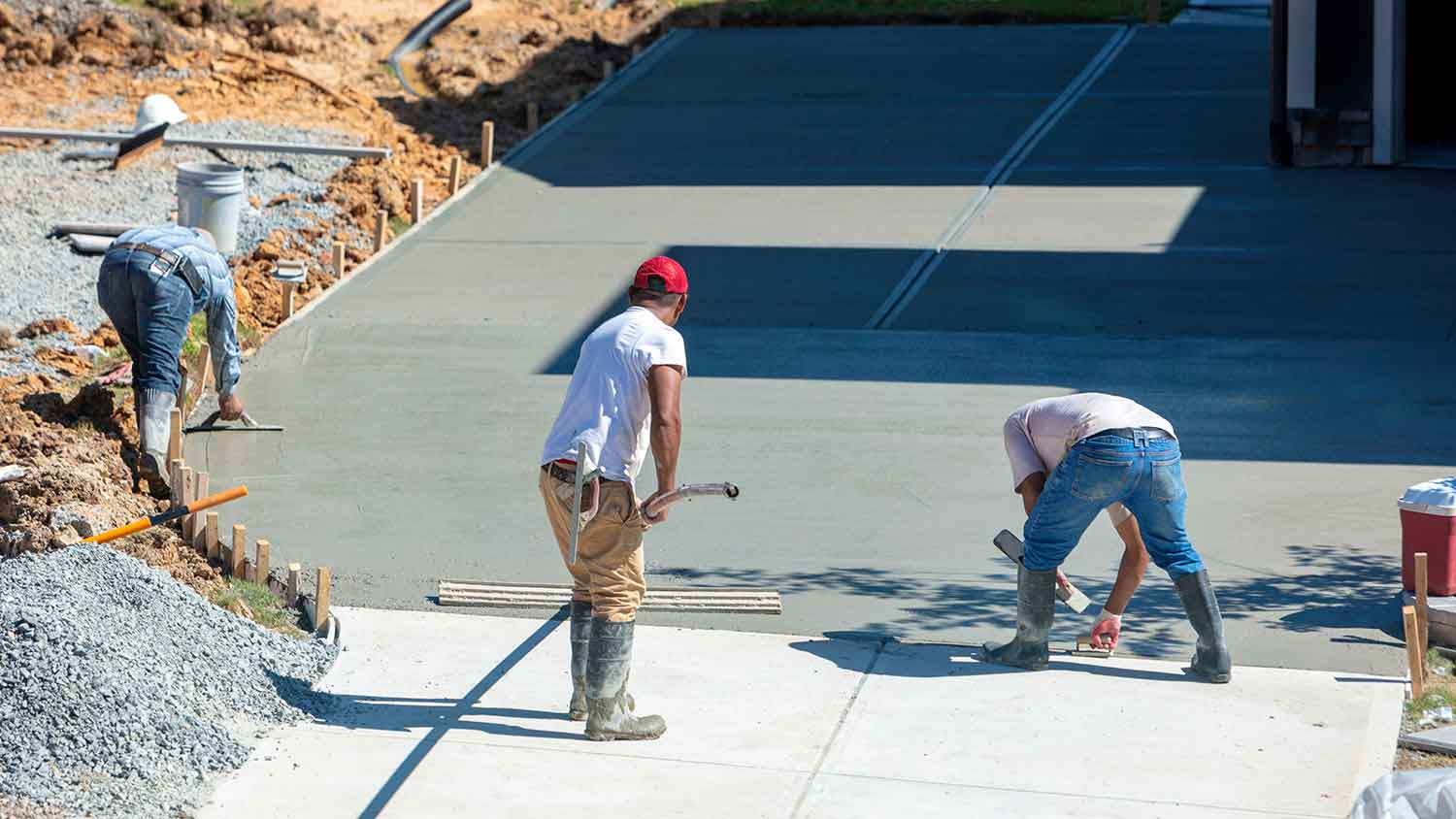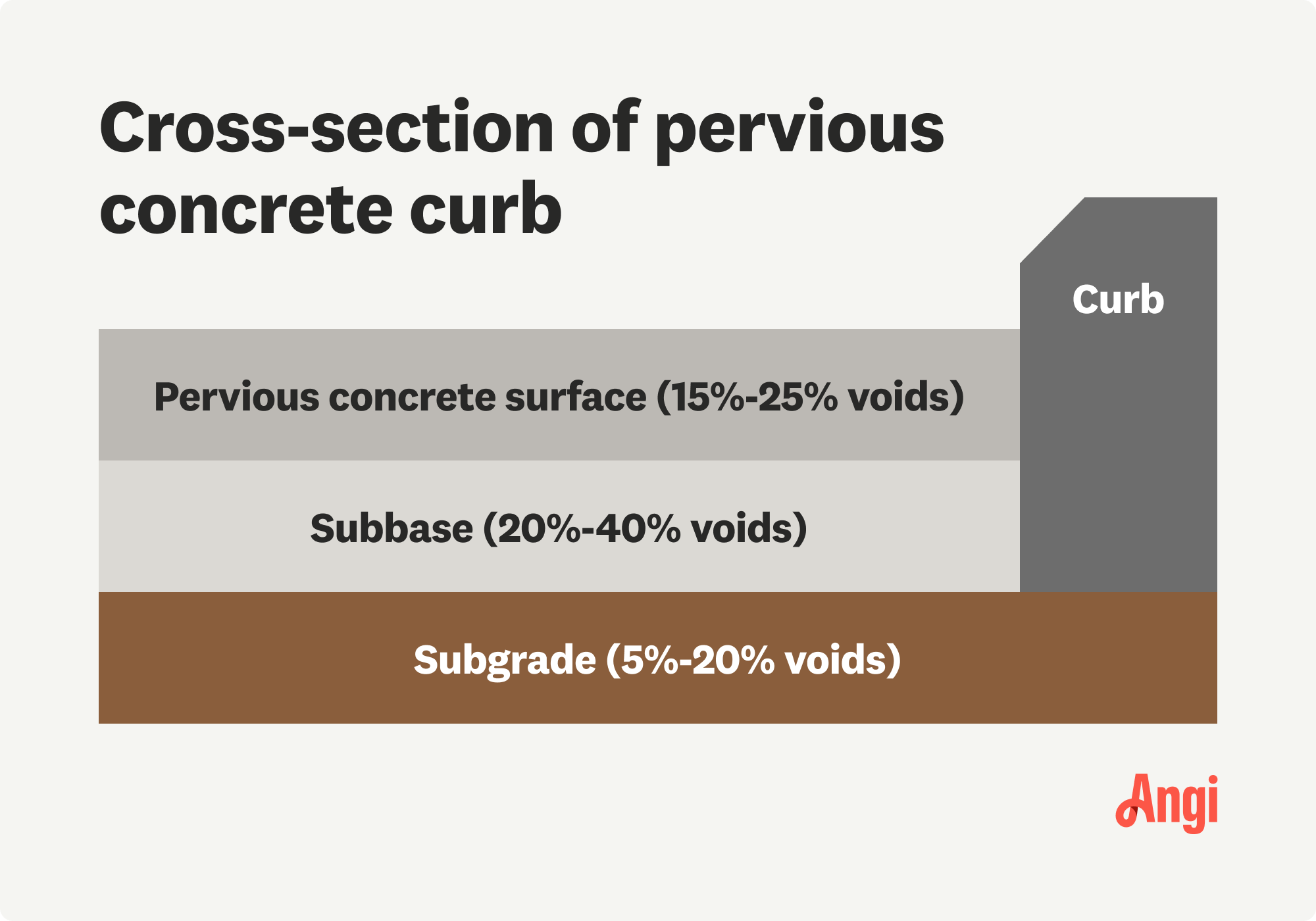
Discover the average concrete pumping cost, including key price factors and tips to help you budget for your next concrete project.
Avoid flooding and drainage problems with this fast-draining concrete


Most homeowners pay around $8 to $20 per sq. ft. for pervious concrete projects.
Prices for a pervious concrete driveway average $1,440 to $5,280.
Permeable concrete can be used for patios, driveways, and walkways.
If you love having a concrete patio, walkway, or driveway but have issues with standing water or drainage, pervious concrete might be the answer you’re looking for. Pervious (or permeable) concrete costs more than traditional concrete but can prevent pooling and surface flooding while also providing environmental benefits. Learn more about pervious concrete, including how it works, its benefits and drawbacks, and how much it costs, so you can decide if it’s the right choice for your home.
Pervious concrete is a non-structural type of concrete suitable for “flat work” applications, which include patios, driveways, sidewalks, walkways, and—in some cases—parking lots.
Like traditional concrete, it’s made of rock, a cementitious material like cement, and water. However, the ratio of larger rock pieces to the other components is much higher. The final product translates to large voids running through the material.
The primary benefit of this permeable paving material is that those voids allow water to flow through it rapidly. In areas where flooding or pooling water can be risks, pervious concrete can allow excess water to flow safely into the soil without much interruption. However, the voids also make it weaker than other types of concrete.
Unlike traditional concrete, pervious concrete uses little to no sand in its composition. When used in traditional concrete, sand is an aggregate to fill voids between larger pieces of material in the aggregate mixture. Without sand, pervious concrete has a larger volume of voids, between 15% and 25% of the total aggregate volume. These voids make the mixture more porous, which allows water to drain through the material rather than pooling on top.
Pervious concrete can drain a substantial amount of water very quickly, with most 5-inch thick surfaces able to store up to 1 inch of rainwater within the concrete’s voids, which increases to up to 3 inches when poured over a 6-inch sub-base of gravel or crushed rock. Pervious concrete can drain water at a rate of 3 to 8 gallons per square foot per minute, so even in heavy rain, water will drain quickly instead of pooling on the surface as it would on traditional concrete.


There are many benefits to using permeable concrete over traditional concrete. These include the following:
Minimal runoff: Pervious concrete allows water to flow into the soil rather than into stormwater drains. This can be particularly helpful in areas where outdated or undersized drainage systems can get overwhelmed by rainfall.
Reduced pollution: Permeable concrete often doesn’t require sealers or bonders like traditional concrete. According to the National Library of Medicine, the result is fewer contaminants in stormwater runoff, a major environmental benefit.
Reduced need for drainage systems: In some cases, drainage systems are required in or around driveways, patios, and parking lots. Since pervious concrete drains water naturally, it often doesn’t need any additional system installed, which means lower installation costs in some cases.
Cooler surface: Pervious concrete doesn’t trap heat as readily as traditional concrete because of the voids. That can mean a more comfortable walking surface in warmer weather.
Lower risk of freezing: Pervious concrete won’t trap water on top of it, which means there’s minimal risk of rain or snow freezing and becoming a slipping hazard.
Pervious concrete certainly has its benefits, but some downsides make it unsuitable for certain projects. Below, we’ll look at some of the most significant drawbacks to using pervious concrete:
Weaker than traditional concrete: Since pervious concrete doesn’t use fine aggregates like traditional concrete, it’s not as strong. As such, you shouldn't use it for heavily trafficked surfaces like roadways, nor should it be used in construction, as in the case of a home foundation.
Requires ongoing maintenance: The voids that allow permeable concrete to drain water can get clogged with dirt and other debris, reducing the concrete’s drainage capabilities. Pervious concrete will need annual maintenance to keep those voids clear.
Can be challenging for DIYers: Permeable concrete is more challenging to use in larger applications than traditional concrete. You can certainly still tackle that pervious concrete driveway on your own, but it will take some careful planning and research to get the mixture just right.
Not ideal over expansive soil: If the soil beneath pervious concrete is expansive, like soil rich in clay, then draining runoff through the concrete can be problematic. Expansion and contraction can weaken the concrete above and lead to cracking.
Since pervious concrete is weaker than traditional concrete, its uses are more limited. It’s generally only suitable for “flat work,” including patios, driveways, walkways, and parking lots, and it’s not strong or durable enough to use as structural concrete for foundations.
On average, pervious concrete costs between $8 and $20 per square foot, which includes materials and labor. This is about double the cost of using traditional concrete. Let’s take a look at some average cost ranges for common pervious concrete projects.
A pervious concrete driveway can cost between $1440 and $5280, while the cost of a concrete walkway made from pervious concrete can range from $640 to $5600. Looking to add a new patio? A pervious concrete patio costs between $1340 and $7200.
While the cost per square foot for permeable concrete is about double what you’d spend on traditional concrete, you’ll likely find that the total cost of hiring a local concrete contractor for a larger project like a driveway or parking lot will often be less expensive when using pervious concrete. Using permeable concrete will demand a thicker slab to be poured for strength, but the lack of a drainage system beneath the concrete can end up saving money overall.
Pervious concrete can be a great alternative to traditional concrete, provided it’s not being used for structural purposes. Pervious concrete driveways, walkways, and patios can promote rapid drainage, reduce pollution of stormwater systems, and leave you with a cooler surface that’s foot traffic-friendly.
Pervious concrete is more expensive on a per-square-foot basis and requires ongoing concrete maintenance, but the benefits often make it a worthwhile option for certain residential applications.
From average costs to expert advice, get all the answers you need to get your job done.

Discover the average concrete pumping cost, including key price factors and tips to help you budget for your next concrete project.

Installing new concrete steps can enhance your home’s curb appeal. Learn all the factors that can affect your concrete steps cost.

Concrete is a durable material but needs maintenance every few years. Use this concrete resurfacing cost guide to get an idea of ongoing maintenance costs.

Concrete spalling can create hazardous conditions. Learn about the causes of spalling concrete, along with helpful prevention and repair tips.

Learn how to repair those naturally occuring concrete cracks and restore your concrete driveway, walkway, or other surface.

Concrete efflorescence can affect the stability of structures. Learn about concrete efflorescence, including ways to repair it and prevent it from happening in the future.